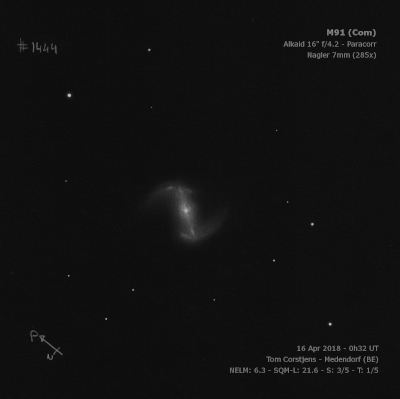
Charles Messier discovered M91 = NGC 4548 = H II-120 = h1345 on 18 Mar 1781. For a long time M91 was a missing Messier object as there is nothing in his position. In "The Missing Messier Objects" (Sky & Tel Oct 1960), Owen Gingerich concluded that M91 was likely a duplicate observation of M58 (same RA as Messier's position for M91 but differs by 2° in dec). Gingrich noted that M91 had been previously proposed to be a comet (suggested by Harlow Shapley and Helen Davis). But in 1969 Texas amateur William C. Williams of Fort Worth figured out that Messier had determined its position using offsets from M89, though he assumed it was from M58. Making this correction, the position of M91 matches NGC 4548.
William Herschel independently found this galaxy on 8 Apr 1784 (sweep 187) and recorded H II-120 as "L, resolvable, but moonlight [end of a long night]." John Herschel made 3 observations, first logging this galaxy on 3 Apr 1826 (sweep 24) as "pB; R; bM; 60" [diameter]."
400/500mm - 17.5" (5/23/87): bright, moderately large, elongated 3:2 SW-NE, 3'x2', gradually increases to a bright core and a very small nucleus. M88 is 50' WSW.
600/800mm - 24" (5/22/17): at 282x; very bright, large, strongly concentrated with a very bright round core that elongates into a bar oriented WSW-ENE. The initial portions of spiral arms are attached at both ends of the bar. On the WSW end, a weak arm extends north, curving slightly counter-clockwise and on the east end, a subtle arm starts to curl south. Both arms blend into a low surface brightness outer halo that extends ~3.5'x2.5'.
CGCG 099-097 was picked up 6.6' SE of the center of M91. At 375x it was very faint, small, slightly elongated SW-NE, ~18"x14", low surface brightness.
Notes by Steve Gottlieb